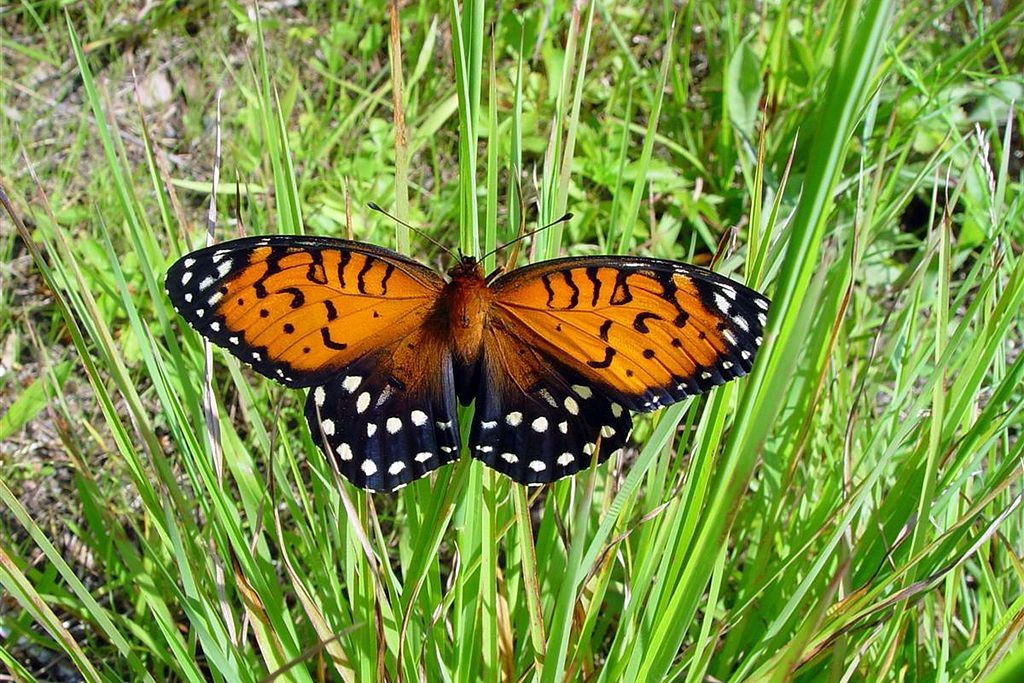Editor’s note from Laura Belin: This week Iowa wildflower Wednesday highlights the regal fritillary, an insect species that depends on plants native to the tallgrass prairie.
Kara Grady is a writer and plant enthusiast from eastern Iowa. Her work has been published by the Iowa Native Plant Society, Lyrical Iowa, Bleeding Heartland, and most recently by the Women, Food, & Agriculture Network. She currently lives and writes in northeast Ohio.
With the 2024 presidential election looming large, I wanted to shift our focus to perhaps an even more serious candidacy. This candidate has lived in Iowa their whole life and is admired throughout the state. Its platform focuses on ecosystem restoration and insect education. It is one of the largest, most beautiful butterflies, whose host plant is an equally beautiful and common wildflower.
With all these credentials to its name, it may shock some people that to this day, the regal fritillary still hasn’t been named Iowa’s State Insect. There are many good reasons to do so.
Let’s start by outlining Iowa’s existing state symbols: the wild rose (state flower), the geode (state rock), the American goldfinch (bird), and the oak (tree). According to the State Symbols USA website, Iowa has fewer symbols than any other state. And while 48 states have a designated state insect, Iowa and Michigan have none.
The last time our people designated a state symbol was with the geode in 1967. Has our state pride for Iowa and what inhabits our land dried up in the last 57 years?
Some people may already be nodding their heads. Of course we should have a state insect! Let’s pick one everyone knows, like the monarch butterfly or the honeybee. Yet those happen to be two of the most overused state symbols; they are the state insects of 25 states combined. In addition, six states have designated the ladybug, and five have chosen the tiger swallowtail.
None of those insects have a unique relationship to Iowa. In contrast, the regal fritillary is native to the tallgrass prairie, which is now being restored in many parts of our state. It is a large, identifiable species with a 4-inch wingspan of vibrant orange, soft maroon, rich browns, sweet creams, and a hint of deep purple. Its host plant is the native prairie violet, whose leaves it chews on throughout the spring as it molts six times over. (Now that’s a hungry caterpillar!)
The regal fritillary’s fascinating lifecycle begins with egg-laying in the fall, followed by winter dormancy among leaf litter. Then it emerges in the spring and eventually grows its sunset wings for take-off as a full-fledged adult.
Becoming our state insect wouldn’t give the regal fritillary any new conservation statuses or protections, though Iowa’s population of this stunning butterfly is threatened due to habitat loss. But it would inform the public of its beauty and resilience, two attributes it shares with Iowa.
This author hopes that recognizing the regal fritillary would allow Iowa to follow Tennessee’s example in naming a state butterfly as well as a state agricultural insect. So folks who think the honeybee is an obvious choice, cool your jets.
While efforts to make the regal fritillary our state insect have come and gone in the past, this author believes its time for a new approach. If you believe this butterfly deserves it, please sign this petition.
Thanks to Nathan Brockman for educating this author about the regal fritillary and Iowa’s state symbols. The Reiman Gardens website has more information about the case for making the regal fritillary Iowa’s State Insect.

Range map by Megan McCarty showing the distribution of the regal fritillary is available via the Creative Commons Attribution-Share Alike 3.0 Unported.

Top image: Speyeria idalia, a.k.a. the Regal Fritillary at Fort Indiantown Gap, Pennsylvania in 2008. Photographed by the Pennsylvania Army National Guard, available via Wikimedia Commons.


1 Comment
Thank you, Kara Grady
I have long hoped that the regal fritillary will become Iowa’s state insect someday. Unfortunately, the odds seem to be against that as long as this state is so controlled by the Iowa Farm Bureau. But, as with Iowa water, we need to keep trying.
The regal’s official “Special Concern” status is justified. Two local populations have winked out in the last thirty years. I am lucky enough to be involved with a parcel of private land that still has regals, but we can never take them for granted.
Also, just as clarification, prairie violets are indeed “common” in the sense that they can generally be found in good-quality original prairies and in certain unusually-high-quality prairie plantings. Unfortunately, prairie violet is not “common” like many non-native invasives (dandelions, white clover, etc.) And prairie violet isn’t even nearly as common as the native prairie flowers that usually show up now in Iowa prairie plantings (gray-headed coneflower, black-eyed susan, etc.)
In my area, prairie violets are found only in a few surviving prairie remnants (less than three hundredths of one percent of the landscape) and a very few prairie plantings. Finding prairie violets in a previously-unknown location is rare and cause for real excitement.
Regal fritillaries used to be abundant, flying over about eighty-five percent of Iowa. Today, the map shows only scattered little regal sites. Regals, along with Iowa’s other declining beautiful butterflies, need help. Our grandchildren deserve to see them too.
PrairieFan Thu 18 Jul 6:04 PM